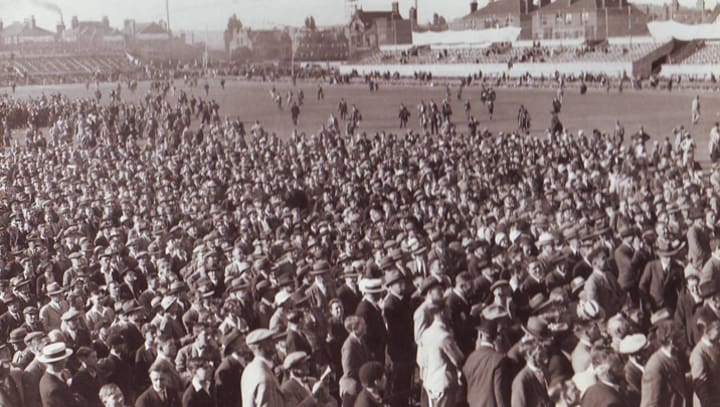Anxious eyes were cast on Nottingham as the morning of the first day’s play between England and Australia dawned in the First Test Match of 1934.
In the Spring and early Summer of that year the general public in Nottingham was thoroughly disgusted with the body that governed English cricket. The County’s two greatest bowlers had been effectively ostracized for simply carrying out the instructions of England’s captain. The press spent the months leading up to the Trent Bridge Test wondering if the England selectors would dare to pick either Harold Larwood or Bill Voce, or even both of them for the match.
When England had last gone to Australia in the winter of 1932-33, the major obstacle to regaining The Ashes was a certain Don Bradman. He had come to England for the first time in 1930 and finished the Test series that summer (without the aid of any ‘not outs’ to falsely bolster his statistics) with a batting average of 139.14.
The English Test captain, Douglas Jardine, with some advice from the Notts and former England captain, Arthur Carr, had devised a plan of leg-theory bowling, which he felt would curb Bradman’s run-getting powers. To work, the plan required exceptionally accurate line and length bowling at an exceptional pace. The Notts pair of Harold Larwood and Bill Voce, with Bill Bowes, delivered the goods, and Bradman's batting average dwindled to a mere 56.57 (this figure is of course considered quite outstanding for ordinary mortals - Brian Lara’s career Test average is 52.88). England won the Test series at a canter.
The Australian press went into hysterical mode, dubbing the bowling ‘bodyline’ and questions were asked in Parliament. Dare I guess that more books have been written about this subject than any other single sporting topic – two more are about to make their appearance.
To rub salt into the wounds, Larwood and Voce were asked to write letters of apology to the MCC before they would be considered for Test selection again.
That was the background for the First Test Match of 1934 (Douglas Jardine had retired from first-class cricket and would be found in the press box for the coming series).
Media interest was enormous. Would the Nottingham public demonstrate their disgust at the absence of Larwood and Voce?
The film rights had been sold to Gaumont British Co.Ltd for £250 and the still photographic rights to Central Press. To protect the broadcasters, spectators were searched, not for drink (40,000 glass bottles were cleared off the ground after one day’s play), but for cameras and these were locked away until play ended.
A rival film company built a great scaffold on the corner of Bridgford Road and Musters Road with cameramen perched on the top. Gaumont British erected screens on top of the boundary wall to block the view, then as the scaffold rose higher, balloons were flown above the screens. The banned film company hired a car which drove close to the Bridgford Road boundary. A man clambered on top of the car and cut the guy ropes, releasing the balloons which were then seen floating off towards Market Square.
But in contrast to the off-field shenanigans the cricket was rather tame. England collapsed twice, not to some fiendish fast bowling but to the spin of Bill O’Reilly and Clarrie Grimmett and Australia won with ease. They recaptured The Ashes and Bradman had a batting average of 94.75 for the series.
Harold Larwood never played for England again but Bill Voce went to Australia again in 1936-37 and was England’s leading bowler.
The Boy from Bowral
Sir Donald Bradman died in 2001 aged 92, retaining the right to call himself the best Test batsman of all time with his average of 99.94 yet to be topped.
Bradman, often referred to as The Don, honed his skills by practising with a stump and a golf ball in his formative years and Australian captain Bill Woodfull said that he was ‘worth three batsmen’ to the national side.
His run of 13 first-class fixtures without a century prompted suggestions that Bodyline had shattered his confidence and technique but having amassed just 133 runs in five innings, he came to life in the Fourth Test at Headingley in 1934 scoring 304 runs. His 473-ball innings included 43 fours and 2 sixes but rain prevented Australia from capitalising on the knock.
Bradman’s 451-run partnership with Bill Ponsford in the Fifth Test at The Oval helped Australia to regain the Ashes. England would not recover them again until after Bradman’s retirement.
